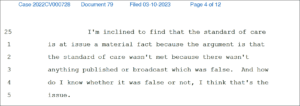U.S. law makes it virtually impossible to be successful in any action against the news media as journalistic accountability is vague under the guise of the First Amendment. Although many in the industry strive to do their jobs with integrity, this legal ambiguity does open the door for the possibility of slanting stories by leaving out inconvenient or politically incorrect facts, context, perspective, or proportion that give a complete story. Thus, a story is then “true” in that it doesn’t violate the law, but it is not the full story, and therefore, is ultimately untrue.
Despite this gray area of law presenting an uphill climb and ultimately yielding an unsuccessful action, the judge did reject an attempted defense claim that nothing published was false. As shown below, the judge implied that the news accounts were not the default set of facts and instead asserted that the Court hadn’t yet established what was true. This isolated ruling was a major win because the entire premise of the civil action was based upon the fact that the narrative of events presented in the criminal complaint, and subsequently the media, were not accurate. Attempts to remove any remaining sensationalized media stories from 2016 are ongoing.













